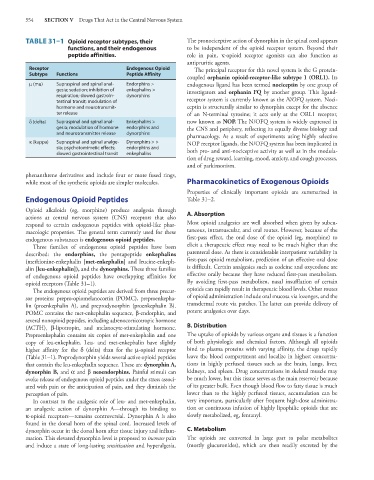Page 568 - Basic _ Clinical Pharmacology ( PDFDrive )
P. 568
554 SECTION V Drugs That Act in the Central Nervous System
TABLE 31–1 Opioid receptor subtypes, their The pronociceptive action of dynorphin in the spinal cord appears
functions, and their endogenous to be independent of the opioid receptor system. Beyond their
peptide affinities. role in pain, κ-opioid receptor agonists can also function as
antipruritic agents.
Receptor Endogenous Opioid The principal receptor for this novel system is the G protein-
Subtype Functions Peptide Affinity
coupled orphanin opioid-receptor-like subtype 1 (ORL1). Its
μ (mu) Supraspinal and spinal anal- Endorphins > endogenous ligand has been termed nociceptin by one group of
gesia; sedation; inhibition of enkephalins > investigators and orphanin FQ by another group. This ligand-
respiration; slowed gastroin- dynorphins
testinal transit; modulation of receptor system is currently known as the N/OFQ system. Noci-
hormone and neurotransmit- ceptin is structurally similar to dynorphin except for the absence
ter release of an N-terminal tyrosine; it acts only at the ORL1 receptor,
δ (delta) Supraspinal and spinal anal- Enkephalins > now known as NOP. The N/OFQ system is widely expressed in
gesia; modulation of hormone endorphins and the CNS and periphery, reflecting its equally diverse biology and
and neurotransmitter release dynorphins
pharmacology. As a result of experiments using highly selective
κ (kappa) Supraspinal and spinal analge- Dynorphins > > NOP receptor ligands, the N/OFQ system has been implicated in
sia; psychotomimetic effects; endorphins and both pro- and anti-nociceptive activity as well as in the modula-
slowed gastrointestinal transit enkephalins
tion of drug reward, learning, mood, anxiety, and cough processes,
and of parkinsonism.
phenanthrene derivatives and include four or more fused rings,
while most of the synthetic opioids are simpler molecules. Pharmacokinetics of Exogenous Opioids
Properties of clinically important opioids are summarized in
Endogenous Opioid Peptides Table 31–2.
Opioid alkaloids (eg, morphine) produce analgesia through A. Absorption
actions at central nervous system (CNS) receptors that also
respond to certain endogenous peptides with opioid-like phar- Most opioid analgesics are well absorbed when given by subcu-
macologic properties. The general term currently used for these taneous, intramuscular, and oral routes. However, because of the
endogenous substances is endogenous opioid peptides. first-pass effect, the oral dose of the opioid (eg, morphine) to
Three families of endogenous opioid peptides have been elicit a therapeutic effect may need to be much higher than the
described: the endorphins, the pentapeptide enkephalins parenteral dose. As there is considerable interpatient variability in
(methionine-enkephalin [met-enkephalin] and leucine-enkeph- first-pass opioid metabolism, prediction of an effective oral dose
alin [leu-enkephalin]), and the dynorphins. These three families is difficult. Certain analgesics such as codeine and oxycodone are
of endogenous opioid peptides have overlapping affinities for effective orally because they have reduced first-pass metabolism.
opioid receptors (Table 31–1). By avoiding first-pass metabolism, nasal insufflation of certain
The endogenous opioid peptides are derived from three precur- opioids can rapidly result in therapeutic blood levels. Other routes
sor proteins: prepro-opiomelanocortin (POMC), preproenkepha- of opioid administration include oral mucosa via lozenges, and the
lin (proenkephalin A), and preprodynorphin (proenkephalin B). transdermal route via patches. The latter can provide delivery of
POMC contains the met-enkephalin sequence, β-endorphin, and potent analgesics over days.
several nonopioid peptides, including adrenocorticotropic hormone
(ACTH), β-lipotropin, and melanocyte-stimulating hormone. B. Distribution
Preproenkephalin contains six copies of met-enkephalin and one The uptake of opioids by various organs and tissues is a function
copy of leu-enkephalin. Leu- and met-enkephalin have slightly of both physiologic and chemical factors. Although all opioids
higher affinity for the δ (delta) than for the μ-opioid receptor bind to plasma proteins with varying affinity, the drugs rapidly
(Table 31–1). Preprodynorphin yields several active opioid peptides leave the blood compartment and localize in highest concentra-
that contain the leu-enkephalin sequence. These are dynorphin A, tions in highly perfused tissues such as the brain, lungs, liver,
dynorphin B, and α and β neoendorphins. Painful stimuli can kidneys, and spleen. Drug concentrations in skeletal muscle may
evoke release of endogenous opioid peptides under the stress associ- be much lower, but this tissue serves as the main reservoir because
ated with pain or the anticipation of pain, and they diminish the of its greater bulk. Even though blood flow to fatty tissue is much
perception of pain. lower than to the highly perfused tissues, accumulation can be
In contrast to the analgesic role of leu- and met-enkephalin, very important, particularly after frequent high-dose administra-
an analgesic action of dynorphin A—through its binding to tion or continuous infusion of highly lipophilic opioids that are
κ-opioid receptors—remains controversial. Dynorphin A is also slowly metabolized, eg, fentanyl.
found in the dorsal horn of the spinal cord. Increased levels of
dynorphin occur in the dorsal horn after tissue injury and inflam- C. Metabolism
mation. This elevated dynorphin level is proposed to increase pain The opioids are converted in large part to polar metabolites
and induce a state of long-lasting sensitization and hyperalgesia. (mostly glucuronides), which are then readily excreted by the

